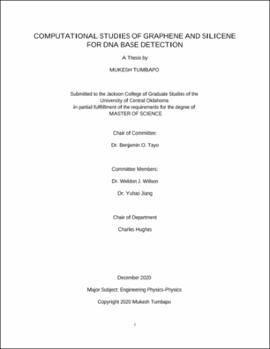| dc.description.abstract | Graphene's success for nanopore DNA sequencing has shown that it is possible to explore other potential single- and few-atom thick layers of elemental 2D materials beyond graphene (e.g. phosphorene and silicene), and also that these materials can exhibit fascinating and technologically useful properties for DNA base detection that are superior to those of graphene. The buckled honeycomb structure, tunable bandgap, and high thermal stability of silicene makes it an ideal material that can be used for designing the active components of nanodevices for biosensing applications such rapid sequencing of DNA. Additionally, the tunable bandgap of silicene provides versatile electronic and thermal properties allowing silicene to be tuned into both a semi-metallic material and a semiconducting material. Due to the remarkable properties of silicene, it is therefore extremely important to perform exploratory studies to determine silicene's ability to detect individual DNA bases as this material is being sought after by many experimental groups as a promising alternative to graphene for designing nano-bioelectronic devices for high-speed DNA sequencing. In this thesis, using density functional theory (DFT), we studied the interaction of DNA bases with finite-size nanomaterials from silicene and graphene. To determine the potential of monolayer silicene as a DNA sensing material, we performed first-principal calculations based on two device concepts, namely, nanoribbon and nanopore devices. Due to the differences in structural and electronic properties of DNA bases, each base is expected to have a unique interaction with the silicene, or graphene monolayer material and this interaction was modeled and quantified using density functional theory. In this research, we found that silicene devices have lower binding energies compared to graphene devices, reflecting the minimal sticking of DNAivbases to silicene's surface in the optimized structures. We noticed a significant change in bandgap for DNA bases using silicene nanopore device compared to graphene devices. Furthermore, the silicene devices with DNA bases show a greater change in density of state signal compared to graphene. We also observed that the silicene nanopore device performs better than the graphene nanopore device. These findings support the idea of silicene being a potential candidate material for advanced DNA base detection using the transverse tunneling current modality. We hope that the findings of this research will provide useful insights that can serve as a guidance to experimentalists and material scientists working in the field. Ideas for future research include examining this system using a periodic calculation; simulate a real device and calculate the current spectrum; and expanding the research to include other single-layer materials such as transition-metal dichalcogenides, and Van der Waals heterostructures. | en_US |
